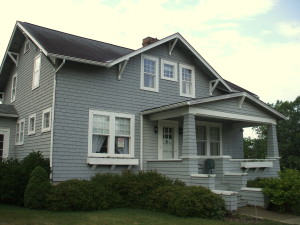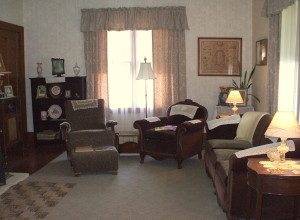Amelia Earhart (born: July 24, 1897 presumed dead: July 2, 1937) was an American aviator who was the first female pilot to fly solo across the Atlantic Ocean. She was born in Atchison, Kansas, her parents were Samuel “Edwin” and Amelia “Amy” Earhart and she had a younger sister, Grace. Amelia and her sister were a couple tomboys exploring their neighborhood, climbing trees and catching toads.
Amelia’s father was a claims officer for the Rock Island Railroad and in 1907 he was transferred to Des Moines, Iowa. Amelia and her sister stayed in Kansas with their maternal grandparents and two years later they were reunited with their parents in Des Moines. By this time Amelia’s father had become an alcoholic and eventually he was forced to retire from his railroad job. The family then moved to Minnesota, but Amelia’s father also lost that job. Amelia’s mother finally left and took her daughters to Chicago where Amelia graduated from Hyde Park High School in 1916. Throughout her unhappy childhood, Amelia continued to dream about her future career and she greatly admired strong women who were able to have successful careers in predominantly male businesses such as: medicine, law and even mechanical engineering.
After high school she enrolled in a college in Pennsylvania but in 1917 she took a trip to see her sister in Toronto. At that time World War I was being fought in Europe; Amelia decided to stay in Canada and began working as a volunteer at the local hospital taking care of the wounded soldiers. When the deadly Spanish Flu epidemic reached Toronto in 1918, Amelia was still working at the hospital and after being exposed to the dreaded illness, she was soon hospitalized with pneumonia and a severe sinus infection. She recuperated with her sister, now living in Massachusetts and spent her time regaining her strength staying in bed reading poetry and studying mechanics but her severe sinusitis was to significantly affect Amelia later in her life when she began flying airplanes.
By 1919, Amelia was preparing to continue with her college education and had enrolled at Columbia University to study medicine but she eventually quit after a year and moved to be with her parents who had reconciled and were now living in California. While at a Long Beach airfield, she took a ride on an airplane and from that moment on she was determined to learn how to fly. She took several different jobs to earn the money for the flying lessons, cut her hair short and began wearing a leather jacket just like the other aviators. Over the next few years, Amelia gained experience through transcontinental flights; gradually her piloting skills improved and she started setting world records. Experienced professional pilots that flew with her started to acknowledge that she was one of the best female pilots in the world.
Then, after Charles Lindbergh’s famous solo flight across the Atlantic in 1927, there was increased interest as to who would be the first women to achieve a solo flight. In 1928, Amelia became the first female to fly solo round trip on a transcontinental flight across North America. She instantly became a famous international celebrity and with her striking resemblance to Lindberg, she became known as “Lady Lindy”. She published a book, started a series of lecture tours to promote the book and began endorsing and even actively participating in the advertising of various products, such as Lucky Strike cigarettes, a line of women’s clothing sold through the Macy’s department store and she even endorsed a line of travel luggage. Through an agreement with her book publisher, George Putnam, their marketing campaign successfully established Amelia as a world famous aviator, even earning the nickname “Queen of the Air”. Through these “celebrity” endorsements, Amelia was able to finance and continue her aviation career.
In 1929, along with Charles Lindberg, she help to establish and promote a commercial and passenger airline service known as Transcontinental Air Transport which became the first regional shuttle between New York and Washington, D.C., this airline later became known as TWA. At this time, Amelia became involved with an organization of female pilots that provided support for women in aviation; she became the group’s first president and suggested the name of “The Ninety-Nines” which was the number of the charter members. In 1930, Amelia became an official of the National Aeronautic Association and she started to promote an establishment separate women records.
Amelia married George Putnam, her book publisher, on February 7, 1931. She referred to her marriage as a true partnership and believed in equal responsibilities and instead of being referred to as Mrs. Putnam, she kept her own name of Earhart. George and Amelia had no children of their own, but he had two sons from a previous marriage.
On May 20, 1932, at the age of 34, Amelia left from Newfoundland with the intention of flying to Paris to duplicate Lindberg’s solo flight. After almost 15 hours with a rough flight of strong winds, icy conditions and mechanical problems, she touched down in Northern Ireland, today there is a small museum at the site. Amelia received many awards after becoming the first women to fly a solo nonstop transatlantic flight. The Distinguished Flying Cross from the United States Congress, and the Gold Medal of the National Geographic Society presented to her by President Herbert Hoover. Between the years of 1930 to 1935, Amelia set seven women’s speed and distance aviation records.
By 1934, Amelia and her husband were now living in California. George had sold his interest in the New York based publishing company and he took a job as head of the editorial board at Paramount Pictures. They lived in a small house in Toluca Lake located in the San Fernando Valley near the studio. Amelia in partnership with Paul Mantz, a former airplane racing and movie stunt pilot, opened up a Flying School at the Burbank Airport.
Finally by 1936, Amelia began preparing for her round-the-world flight; it would be the longest flight to date at 29,000 miles following the difficult equator route. Amelia was currently on the faculty of Purdue University and a technical adviser of their Department of Aeronautics. With financing from Purdue, a Lockheed Electra 10E aircraft was built to Amelia’s specifications at the Lockheed Aircraft Company located near the Burbank Airport. For this complicated flight Amelia hired two navigators, Harry Manning and Fred Noonan. The original plan was to have Noonan navigate from Hawaii to Howland Island, a very difficult portion of the flight, then Manning would continue with her to Australia and she would complete the remainder of the flight by herself.
In March 1937, Amelia flew with her crew from Oakland, CA to Honolulu, Hawaii. During this portion of the flight, they had some engine problems and stopped to service the plane. Three days later, they took off from the U.S. Navy Luke Field in Pearl Harbor and upon take-off the plane either blew a right tire or the right landing gear collapsed. The flight was cancelled due to the severe damage to the plane and it was shipped back to the Lockheed facility in Burbank for repairs.
Then, in June 1937, after additional funding Amelia attempted the trip once again with only Noonan as her navigator. This second flight was different from the first and they were traveling west to east, the reason for the change of direction was sue to global weather and wind changes. The first portion of the flight was from Oakland to Miami. From there they made numerous stops in South America, Africa, India and Asia. By July 2, she had completed almost two-thirds of the flight, over 22,000 miles. They had reached Lae, New Guinea and with only 7,000 remaining, Amelia and Noonan took off heading toward Howland Island in the Pacific Ocean which was only 2,556 miles away.
Tragically something happened and the plane vanished before it reached Howland Island. Search teams from the Navy and the Coast Guard almost immediately started air and land searches, but they failed to locate the aircraft and were assumed lost at sea. One theory speculates that the plane simply ran out of fuel and crashed into the Pacific Ocean. Another theory is that the plane crashed into another smaller island, possibly Garner Island. There are also numerous conspiracy theories; one is that Amelia and Noonan were spies for the Franklin Roosevelt administration, captured by the Japanese, accused of espionage and killed. Even today, the fate of Amelia Earhart remains as the subject of endless speculation.


